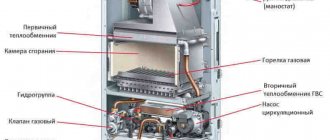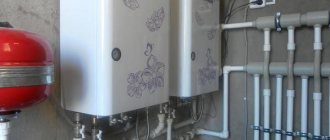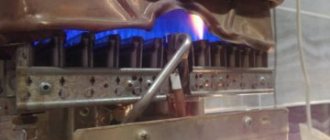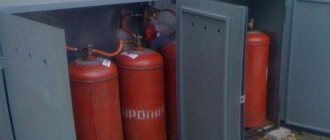During the heating season, homeowners often ask the question: “Why do they have such high gas consumption when using it for heating?” Analyzing the problem, you quite often come to the conclusion that often the gas consumption is, in principle, normal. It’s just that when purchasing a boiler, the homeowner had completely different expectations, which were not met. However, there are situations when gas consumption is really exceeded and the owner of the house cannot understand what is causing this; or when the boiler was working normally, and then for no reason began to consume it in large quantities. This article will discuss all these cases. Find out what causes high gas consumption and how you can reduce it.
Coolant temperature
Proper regulation of the coolant temperature will directly affect gas savings. In the basic configuration, boilers are mostly not equipped with an outdoor temperature sensor, so throughout the heating season the user must independently select the coolant temperature depending on weather changes: either increase or decrease.
This is not entirely convenient, especially since Baxi boilers allow you to connect a sensor as an option. In this case, the term weather-compensated automation can also be used. Then, regulation will occur automatically depending on the climate curve selected in the boiler settings, and the boiler will waste less energy on useless heating, which will lead to gas savings.
Boiler clocking
Clocking is the frequency of switching on equipment for heating the coolant. If no external control devices are connected to the baxi boiler, the interval between turning on the boiler can be set to a maximum of 10 minutes (default 3 minutes).
For example, for the BAXI ECO FOUR boiler, configuration parameter F11 is responsible for this. Burner waiting time between two starts.
Frequent switching on is not economical - the more time the boiler operates continuously, the better. On one of the forums, a user expressed concern about the long-term continuous operation of the boiler, but this, on the contrary, means that a mode has been established in which the heat losses of the room are continuously compensated while maintaining the optimal coolant temperature.
This problem is most pressing for owners of small-sized apartments, because the boiler was initially designed for the preparation of hot water and obviously higher power.
Since the configuration parameter numbers of gas boilers may differ, to configure a specific model you need to study the instructions.
Additional savings tips
In addition to the methods discussed above, there are several other related tricks that can be used to achieve the desired savings.
The following rules should be followed:
- Radiators should not be covered with decorative panels, thick curtains, furniture, or clothing;
- at least once a year it is necessary to clean the boiler heat exchanger from accumulated dirt and dust;
- if the equipment is installed in an unheated room, it is recommended to perform high-quality insulation of the boiler, boiler and outgoing pipes;
- It is advisable to install special energy-reflecting screens made of aluminum foil between the radiator and the wall;
- when using gas to heat water, it is worth installing economical shower heads;
- if the gas water heater is not working, the burner should not be active.
Before the start of the heating season, you need to check the system every time and eliminate all identified deficiencies. Common problems include air locks and leaks at the joints of structural parts.
In order to save gas as much as possible, it is necessary to constantly monitor the condition of places where heat leaks are likely - seal cracks in windows with foam strips, tighten door hinges, additionally upholster doors, blow foam around the boundaries around the inlet and outlet openings of pipes
Saving should be economical, so it is important to control gas consumption everywhere, including in the kitchen. When cooking on the stove, you should adjust the flame at each stage of cooking, reducing the burning intensity at the right time.
For faster cooking and less gas consumption, it is recommended to always cover the dishes with a lid, use special pans with grooves on the bottom, and kettles with a whistle.
How to set a Baxi boiler to economical mode?
For small apartments, it is recommended to set parameters F08 (Maximum net power of the heating system) and F10 (Minimum net power of the heating system) to a minimum. The modulation range of a 24-kilowatt boiler starts at 40% of the maximum power, so the minimum possible operating mode will be 9 kW, which will be quite enough to heat an area of up to 80 square meters. meters and will increase the intervals between switching on, especially in the off-season period.
In addition to saving gas, do not forget that each burner activation involves the main actuators, relay switching on the control board, fan, gas valve, which certainly affects their service life.
Here it is worth mentioning that the most economical mode of a gas boiler will be when operating at maximum power, i.e. with maximum efficiency.
High energy consumption of a gas boiler
If a floor-standing gas boiler has a high gas consumption, look at how the chimney is installed and what type of boiler is installed. A floor-standing gas boiler has one disadvantage compared to a wall-mounted boiler: higher fuel consumption. For countries with low gas prices (Russia, Belarus, Kazakhstan), this difference does not significantly affect gas consumption. But in countries with high energy tariffs and where CO2 emissions are being combated (for example, in Europe), floor-standing gas boilers are generally absent.
If you are the owner of a floor-standing gas boiler and a conventional chimney is not installed according to technology, there will be a high gas consumption. Cases of low-tech chimney installation include:
- The chimney is made of brick (this is prohibited for a gas boiler).
- Ferrous metal pipes are used as a chimney.
- Uninsulated stainless steel pipes are used as a chimney.
Any manufacturer of chimneys for a floor-standing gas boiler will recommend installing an insulated stainless steel sandwich pipe. But this option is the most expensive.
If you have another option installed as a chimney, it is likely that this is the main reason for the high gas consumption of the boiler. Only changing the chimney will help reduce consumption.
Any boilers, both wall-mounted and floor-mounted, are draft-dependent, i.e. they need to create good conditions for traction. If the draft is good, a correspondingly larger volume of air will enter the combustion chamber. In this case, floor-standing gas boilers will completely, as far as possible, pass gas through themselves and burn the amount that gets into it. Otherwise, fuel combustion will not occur completely.
Connecting a room thermostat
Most models of Baxi boilers have the ability to connect a room thermostat. The idea is that the boiler will turn on only by a signal from the thermostat when the air temperature in the room drops below the set one.
Of course, everything is quite individual, and a lot depends on the type and balance of the heating system as a whole, and using only one room thermostat will have a certain inertia.
Programmable thermostats allow you to flexibly set different temperatures throughout the day. Reducing the room temperature by 1 degree throughout the year will result in gas savings of about 4-5%.
In some EU countries, where energy efficiency issues are more meticulous, installing a room thermostat is a mandatory requirement.
Zonal control system
Such a system provides for individual temperature control in each room separately by installing controlled thermal heads on each radiator. That is, depending on the air temperature in a particular room, the amount of coolant in the radiator will be regulated, and the boiler will turn on only when necessary. The use of such regulation will provide maximum savings (about 30%) and comfort in the room. The only disadvantage of such a system is its cost.
The temperature on the boiler is set incorrectly
For example, you decide to save money in winter and keep the room temperature around 18℃. It seems to you that if you set the boiler to 1 (maximum 2), you will create a pleasant microclimate and save gas. But in practice everything turns out differently. You will spend 2-3 times more gas than if the boiler were at 3-4. A paradox, but quite understandable from the point of view of physics.
The problem is especially relevant in large heated areas, when the boiler heats the water, the pump pumps it, and while the coolant has bypassed all the radiators, it returns already cooled. This encourages continuous operation of your equipment. Accordingly, the boiler practically does not turn off, but constantly works and consumes more gas than at higher regulator settings.
Savings and regular equipment maintenance
The basic structure of a traditional gas boiler is almost the same, regardless of the manufacturer. Thermal energy from gas combustion is transferred to the coolant through a heat exchanger. There can be either one or two heat exchangers in the boiler. During operation of any gas boiler, the heat removal surface becomes contaminated with soot deposits from the outside and scale from the inside.
From practice, we can say that it is extremely rare that the system is filled with special prepared water or the water supply system is equipped with a water treatment system. This is especially true for apartment buildings, in which the owners receive a ready-made heating system along with the apartment.
The formation of scale and soot on the walls of the heat exchanger will gradually reduce the heat transfer performance, and more energy will be consumed for heating.
Therefore, annual regular maintenance will definitely affect the efficiency of equipment operation for the better! This especially applies to boilers with bithermic heat exchangers, which, due to their design, are difficult to clean.
Questions and answers
I have a 7.5 kW boiler, but I added 4 more batteries to the heating system. Gas consumption has increased, is it possible to increase the pump speed to save money?
This will not help, since the coolant will not have time to heat your batteries, will quickly cool down and return to the heater. Accordingly, the boiler will work almost non-stop. Try adding more gas; if that doesn’t help, then you need to increase the power of the boiler itself by replacing it.
I wanted to clean the heater, but the product corroded the walls and eventually holes formed. Is there any point in patching or is it better to buy a new one?
It is better to buy a new one, and further descaling treatment should be carried out only with special means and according to the rules. Call special services to help solve the problem.
I have a single-circuit boiler, it worked fine, but recently it literally stopped turning off. Gas consumption is incredible, and the batteries are cold, what is the reason?
Check if the return filter is clogged. To do this, unscrew the thread on the pipe. Perhaps, due to poor quality water, debris has accumulated there, which prevents the full passage of water into the heater. It is also necessary to eliminate scale from the heater and, if necessary, clean it.
The boiler was cleaned of scale, but it began to consume even more gas. The temperature of the batteries did not increase. Could the problem be in the gas itself, or rather in its composition?
Yes, gas quality plays an important role in the heating process. If the proportions of the basic units change, there is a risk that you will have to pay more, but it will still be cold.
Cost optimization
An increase in the temperature in the house relative to the street temperature is only possible if the amount of energy from the heating system exceeds the amount of heat leaving the building due to heat losses.
Consequently, the greater the heat loss at home, the more energy the heating system must produce and, accordingly, the more noticeable consumption of blue fuel. In this case, the main answer to the question “how to save on heating” will be to reduce the wasteful release of heat from the building.
Approximate calculation of gas consumption
So, let’s say you’ve already calculated the heat loss at home. If not, then for most regions a rough value of heat loss of 100 W per 1 square meter is taken. m. Let's say our house has losses of 10 kW and we need to find out how many cubic meters per hour our boiler will consume. To do this, we need to understand how much heat we can get from one cubic meter of gas.
According to GOST, 9.3 kW of thermal energy can be obtained from one cubic meter of gas. Ideally, with 100% boiler efficiency and heat loss of 10 kW, we will spend 0.93 cubic meters of gas per hour.
Analysis of heat losses and ways to reduce them
In a private house, the greatest amount of heat is lost through windows, walls and roof. In addition, a certain amount of thermal energy is lost with the escaping air through the ventilation system, because warm air is replaced by cold outside air. Therefore, the following ways to save on heating are:
Firstly, insulating the roof or attic - using stone wool, foamed polymers, covering the roof with sandwich panels. In each specific case, the choice is made based on the characteristics of building structures and the solvency of the owner.
Secondly, reducing heat loss through windows. There are two acceptable methods here. The first is to reduce the total window area of the entire house, but at the same time reducing the amount of sunlight entering the premises. The second way is to install windows with better energy performance. These are windows with double and triple glazing, multi-circuit window systems and special windows, the glass of which is coated on one side with a thin layer that reflects infrared radiation.
Thirdly, insulating the walls of the house or constructing them from materials with better thermal characteristics.
Automation of the heating process
Even if heat loss in a building is minimized, gas for heating will be wasted if its supply to the burners is not regulated depending on external factors. These factors include the temperature of the external air environment and the temperature inside the heated premises.
Modern gas heating systems must include devices for regulating the fuel supply - boiler automation. This system includes air temperature sensors outside and inside the house. When the outside temperature changes, these devices send a signal to the control system, and the supply to the gas boiler will be increased or decreased.
Temperature sensors installed indoors work in a similar way. The boiler automation system will avoid excessive heating of the coolant in the radiators and will lead to heating savings.
Save money by not heating all rooms equally
Not all rooms and volumes of the house need to be maintained at the same temperature. For example, storerooms, gyms, garages, workshops may have a slightly lower temperature, while children's rooms, showers or bathrooms may have a higher temperature.
To maintain the desired temperature in a particular room, you need to install regulators on each heating radiator. The principle of their operation is simple - they change the working cross-section of the heater pipe and reduce or increase the coolant circulation rate. It is enough to set the required temperature value on the regulator. This measure optimizes the total gas consumption for heating water in the boiler.
Don't release heat into the chimney
A modern smart and environmentally friendly home should take every opportunity to save heating inside its space. This property is given to the home by a heat recovery system. It works like this:
- special heat exchangers are installed in the ventilation exhaust ducts, which remove warm and humid air to the street; they communicate with the inlet ventilation pipes;
- As warm air passes outside, it warms up the cold air coming from the street. Thus, fresh air enters the house already slightly warmed up.
If we calculate how much heat is needed to heat 1 m3 of air by 1°C, we get 0.312 kcal/m3*deg. 1 m3 of gas emits about 8000 kcal during combustion. The efficiency of a gas boiler is about 90%.
In a private house with a living area of about 100 m2, the average air exchange rate per hour should be at least 3 m3 per 1 m2 of area, that is, 300 m3 every hour. This figure will be 7200 m3 per day. Consequently, when heating the incoming air by 10°C, the savings will be 22,464 kcal or about 3 m3 of gas per day for heating.
And if we take into account that the air exchange in kitchens and boiler rooms with gas burners should be, according to SNiP 2.08.01-89* “Residential Buildings”, up to 90 m3/hour for every 1 m2, then we get a saving figure of up to 5-6 m3 of gas every day.
With the cost of blue fuel for the population on average 8 rubles per m3, the savings will be 40-50 rubles daily or up to 1200-1500 rubles monthly for heating.
How to solve?
The contamination of the heater is determined empirically, that is, the boiler should be disassembled, removed and inspected for contamination. It is not recommended to do this yourself, as there is a risk of damaging the parts.
If scale is detected, it should be cleaned. Specialists use acidic solutions that dissolve dense sediment. To avoid possible excess consumption of gas, do not ignore annual descaling of the heater.
Keep water hot
In addition to heating costs, blue fuel is used in a number of houses to heat hot water. The following measures will help reduce the amount of gas consumed:
- installation of a separate flow-type gas heater. It is turned on only when the hot water tap is opened, and fuel is not wasted;
- inclusion of a hot water boiler in one circuit with the heating system. With this option, the cost of heating water for domestic needs will be minimal;
- use of thermally insulated storage tanks for hot water. In such devices, heated water does not cool down for a long time, and there is no need for frequent heating;
- use of solar collectors in water supply systems.
Combining all the methods considered makes it possible to significantly, up to 25-30% or more, reduce the cost of paying for the services of gas supply organizations.
–unknown
–Search by diary
–Subscription by e-mail
–Interests
– Regular readers
–Communities
-Statistics
Sunday, May 28, 2022 21:03 + to quote book
How to save gas: real ways
A country's resources belong to its people. Nevertheless, people have to pay a lot of money for these resources, since their extraction and transportation require the same considerable financial costs. Blue fuel is no exception in this regard, and every time a person pays bills for a consumed resource, the question arises: how to save gas?
This question is especially relevant when it comes to a large house equipped with gas heating. Some people put up with large bills - they say you have to pay for comfort. And some spend precious time and a lot of additional money looking for a solution to the question of how to save gas? I won’t say that they are unsuccessful, but most people are looking for something slightly different from what they need - some are looking for ways to illegally extract fuel from gas pipelines, while others are looking for wonderful technological devices that, as if by magic, reduce gas consumption by almost half, passing by their attention are really real ways to save money. We will talk about them in this article, in which, together with the Dream House website, we will deal with the question of how to really save gas on heating?
Technology
The introduction of a set of measures to reduce the temperature of flue gases behind the boiler at an existing enterprise ensures an increase in the efficiency of the entire installation, which includes the boiler unit, using, first of all, the boiler itself (the heat generated in it).
The concept of such solutions essentially boils down to one thing: a heat exchanger is installed in the section of the flue up to the chimney, which absorbs the heat of the flue gases with a cooling medium (for example, water). This water can be either directly the final coolant that needs to be heated, or an intermediate agent that transfers heat through additional heat exchange equipment to another circuit.
The schematic diagram is shown in the figure:
The resulting condensate is collected directly in the volume of the new heat exchanger, which is made of corrosion-resistant materials. This is due to the fact that the dew point temperature threshold for moisture contained in the volume of exhaust gases is overcome precisely inside the heat exchanger. Thus, not only the physical heat of the flue gases is usefully used, but also the latent heat of condensation of the water vapor contained in them. The apparatus itself must be designed in such a way that its design does not provide excessive aerodynamic resistance and, as a result, deteriorate the operating conditions of the boiler unit.
The design of the heat exchanger can be either a conventional recuperative heat exchanger, where heat transfer from gases to liquid occurs through a dividing wall, or a contact heat exchanger, in which the flue gases directly come into contact with water, which is sprayed by nozzles in their flow.
For a recuperative heat exchanger, solving the issue of acid condensate comes down to organizing its collection and neutralization. In the case of a contact heat exchanger, a slightly different approach is used, somewhat similar to periodic purging of the circulating water supply system: as the acidity of the circulating liquid increases, a certain amount of it is taken into the storage tank, where it is treated with reagents with subsequent disposal of water into the drainage system, or by directing it into the technological cycle.
Certain applications of flue gas energy may be limited due to differences between the temperature of the gases and the specific temperature requirements at the inlet of the energy-consuming process. However, even for such seemingly dead-end situations, an approach has been developed that relies on qualitatively new technologies and equipment.
In order to increase the efficiency of the flue gas heat recovery process, innovative solutions based on heat pumps are increasingly being used in world practice as a key element of the system. In certain industrial sectors (eg bioenergy), such solutions are used on the majority of boilers commissioned. Additional savings in primary energy resources in this case are achieved through the use not of traditional vapor-compression electric machines, but of more reliable and technologically advanced absorption lithium bromide heat pumps (ABTH), which require heat rather than electricity to operate (often this may be unused waste heat , which is present in abundance in almost any enterprise). This heat from a third-party heating source activates the internal ABTH cycle, which allows you to transform the available temperature potential of the exhaust gases and transfer it to more heated environments.
How to save gas: a few words about scams and scams
The first thing you come across on the Internet when you search for how to save gas using a meter is a unique device called GAS SAVER - a real miracle of technology that allows you to reduce gas consumption. Enthusiastic reviews from grateful customers, promotions and discounts on the purchase of several of these devices - in general, everything so that a person does not pass by and buy the treasured device to save gas. Many people buy, thereby enriching the sellers, and many treat it with caution, realizing that miracles do not happen in the world.
Gas saving device photo
Let's not beat around the bush, but let's say frankly - a device for saving gas in a private home is nothing more than a useless magnet. By and large, it can only be used as a holder for small metal rubbish and nothing more. The gas can be structured, as the sellers explain the principle of operation of the device, only by creating a very strong magnetic field of enormous intensity - neodymium magnets are not capable of this. This requires a large industrial installation. Even if you install it, the energy costs will be unjustified.
In general, there is no need to rush to buy a miracle device - at least first you need to ask about its capabilities from happy friends who have already managed to purchase it and throw it in their hearts on the farthest shelf in the pantry.
What's the result?
But in the end everything is simple. If you want less gas consumption, take a wall-mounted gas boiler. If you want to know the gas consumption in your home, ask your neighbor. If you want not to spend money and pay little for gas, then you are unlikely to succeed. Unfortunately, the reality is that everything good related to heating is quite expensive.
In 99.99% of cases, a client buying a gas boiler wonders about its consumption. Piously relying on the “expert calculations” of sellers and trusting them, sometimes you often get burned. Some clients who hear more realistic numbers from us run to the place where the number was lower and still buy a boiler there. So, don’t end up in a field of lies and find out a more detailed figure for gas consumption in order to understand whether you should buy a boiler or not. This is why this article was created.
Saving gas in a private home: method one - insulating the house
There is only one real way to reduce gas consumption - reduce its consumption. For most people, this involves lowering the comfortable temperature in the home and nothing more, but there are ways to save gas that allow you to keep the comfort in your home at the same level. All that needs to be done for this is simply to retain heat - as the builders say, to reduce heat loss to the maximum possible level. To put it even more simply, you need to insulate the house. When the heat lingers in the rooms, willy-nilly you will have to turn on the heating boiler tap - otherwise it will become hot, which is not at all comfortable.
How to save gas using a meter photo
Insulating a house is a very expensive, but effective task. It is a set of measures that provides for comprehensive thermal insulation of the house.
- First of all, these are the walls. The easiest way to insulate them is: the most basic thing is to cover the outside walls of the house with foam plastic. Alternatively, you can create a false wall indoors and lay mineral wool behind it.
- The ceiling is where most of the heat leaves the house. The ceiling in a private house from the attic side is insulated with the same mineral wool or polystyrene foam.
- Floor. The principle is the same - insulation is laid under the screed or wooden flooring.
- Windows and doors. It is better to replace old wooden products of this type with new metal-plastic ones, equipped with energy-saving double-glazed windows.
Approximate calculation of gas consumption
So, let’s say you’ve already calculated the heat loss at home. If not, then for most regions a rough value of heat loss of 100 W per 1 square meter is taken. m. Let's say our house has losses of 10 kW and we need to find out how many cubic meters per hour our boiler will consume. To do this, we need to understand how much heat we can get from one cubic meter of gas.
According to GOST, 9.3 kW of thermal energy can be obtained from one cubic meter of gas. Ideally, with 100% boiler efficiency and heat loss of 10 kW, we will spend 0.93 cubic meters of gas per hour.
And now why this calculation can be called the most inaccurate. Even if the gas complies with GOST, the performance of the boilers is different. A traditional wall-mounted boiler has an efficiency of 92-93%. Therefore, another 8% must be subtracted from 9.3 kW. This will be a more accurate figure.
Another thing is that we calculated the maximum flow rate at the lowest temperature. But this temperature does not always happen. It may be warmer today, colder tomorrow. And the losses will be different. Therefore, from here you can take some average value and you will get the most pessimistic gas consumption figure.
It’s simply impossible to accurately calculate something. (Of course, if you want to conduct a static analysis of temperature measurements in your region over a hundred years, find dependencies and compare everything, then a more accurate calculation will be obtained. But it’s better to stop even thinking about it.)
Saving gas when heating a private home: the boiler decides everything
Pay attention to how your gas boiler operates. Old home heating equipment is distinguished by stable and constant operation - the gas (at least the igniter) burns constantly, consuming blue fuel in exorbitant gulps. In addition, the old boiler turns off the gas supply only to prevent the system from overheating. Agree, all this can only be called wastefulness.
Unlike old-style boilers, modern models of boiler equipment operate more economically - their pilot light is not constantly lit, and the coolant in them is heated only to a given temperature. All this is possible thanks to modern electronics that control the operation of the heating system. In addition, this same electronics eliminates the so-called human factor - you will not be able to forget to turn off the boiler in time or lower the temperature in the system. Yes, you have to pay for all this with a slightly higher consumption of electrical energy, but even so, the bills for paying for resources are reduced by several tens of percent.
Saving gas when heating a private home photo
But this is not the limit of savings. Want more? Then a modern boiler needs to be connected to a real gas saving device - a controller called a thermostat.
How else to effectively reduce gas consumption
There are several other ways to save gas consumed by the boiler. This could be a complete replacement of equipment or the addition of special devices to the system.
We recommend reading on our website: The cost of gas for the population of Russia
Connecting the thermostat and outside air temperature sensor to the boiler
Due to the constantly changing air temperature outside, as well as the wind varying in intensity and direction, the temperature in the premises of a house or apartment is constantly changing. This issue is best resolved by connecting a thermostat, which will adjust the temperature of the water acting as a coolant in the pipes.
You should also install a special outside air temperature sensor. In this case, the water heater will quickly respond to temperature changes outside the house, reducing or increasing its power.
Using interface boiler temperature controllers
An interface, that is, a programmable electronic thermostat allows you to make settings in several heating modes (for example, economical, comfortable, and so on). In addition, such a progressive regulator can work in tandem with a temperature sensor, which further enhances the gas saving effect.
Install a hot water boiler
If the boiler operates simultaneously for heating and hot water supply, you can install a hot water boiler. Thus, the function of heating residential and other premises of a private house will be performed by a boiler, and heating of water for domestic needs (hot water supply) will be carried out by a boiler.
Boiler
Use a gas boiler with an open combustion chamber
If you have a turbo boiler in your house, that is, a device equipped with a closed combustion chamber, you may want to consider replacing it with an atmospheric one. An atmospheric boiler, that is, a unit equipped with an open combustion chamber, has a higher efficiency. This is explained by the fact that in such heaters (unlike turbo-type options) there is no constantly running fan, which promotes air circulation in the system. Along with its beneficial effect, such a unit contributes to significant heat losses, which causes gas consumption for heating to increase unjustifiably.
Also read with this article: Gas consumption for heating a house (calculation example per 100 m2)
The presence of a throttle insert in the chimney
If the amount of air sucked into the burner becomes excessive, this problem can be easily solved by inserting a diaphragm into the chimney. It is also called a diffuser or throttle insert.
This element will also reduce the influence of wind on the normal functioning of the gas burner.
Using a condensing boiler
How to use a gas boiler economically? Purchase a condensing option - unlike a conventional boiler, the water in the condensing unit passes through an additional heat exchanger, preheating it. When the operating mode is correctly selected, the exchanger of such a heater promotes the active conversion of steam into water. Due to the fact that this process occurs at a supply water temperature of 50 0C, such a device can be used for low-temperature heating.
Installation of two boilers instead of one
Installing 2 boilers instead of 1 will help you use gas heating economically. This is reasonable, because in the off-season only one unit can be turned on, and in this case the second one is put into operation when the air temperature drops during a particularly cold winter period.
Also, having two heating devices at once, you don’t have to worry about an unexpected breakdown of one of them.
Installing a filter on a gas pipe
The boiler consumes gas, which contains solid particles and other foreign inclusions. This could be soot or resinous substances that get into the valve and disrupt its operation. The solution to the problem in this case is to install a filter on the gas pipe. The best place for installation is in front of the gas meter, because it also needs protection from contamination.
Saving with a gas meter
You can save not only on the boiler, but also through the proper use of a gas meter.
Since a regular household meter measures the volume of gas passing through a pipe, changes in the temperature and pressure of this fuel are not taken into account in any way. It turns out that the meter may not show real gas consumption, but an increased one. The situation will be saved by installing a meter with a thermal corrector.
Using a single-circuit boiler with a boiler instead of a 2-circuit one
It is known that different types of boilers consume different amounts of gas. To make more efficient use of the resource of such a heater for a home heating system, it is better to use a single-circuit boiler and a separately installed boiler instead of a double-circuit unit. Knowing this feature of the boiler system, many manufacturers produce ready-made kits consisting of a boiler and a remote or built-in boiler.
We recommend reading on our website: The procedure for replacing an old boiler with a new one
Using a room thermostat and heat controller on radiators
If you install a room or radiator thermostat, you will notice that at the same constant temperature in the house, the boiler begins to consume less gas (adjustments can be made manually or automatically). In this case, the unit can become so energy efficient that for half a day it will not turn on at all.
This happens thanks to the precise regulation of air temperature, for which the thermostat will be responsible, because every “extra” degree of air temperature in the room leads to an increase in gas consumption.
Insulation of an apartment or house
It is also possible to establish the average optimal cycling time or the correct cycling of the heater by additional insulation of the heated premises. It is not enough to heat living rooms well; you also need to preserve and retain heat inside the house or apartment.
You should check the windows, doors and other structural elements of the heated building or room to determine in which places it is necessary to stop the heat escaping outside. The most convenient way to do this is to use a thermal imager, a special device that “sees” the temperature of surrounding objects.











